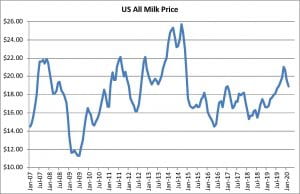Please note that this addresses farmers in Wisconsin, however the principals are relevant to more than just Wisconsin Farms. The insights are timely and pertinent to the way we think about planning for the future of our farms and how to navigate the various obstacles we face in the near future.
Mark Stephenson
Director of Dairy Policy Analysis
University of Wisconsin-Madison
Expert on dairy markets and policy
“Dumping, at least on a wider scale, is a new thing for Wisconsin. We are starting to hear about it here, although my gut tells me it will be less of a problem for us than Wisconsin when everything is said and done. We have vulnerabilities, but our customer base is 1) more diversified, 2) less export dependent, and 3) more oriented to retail sales. Wisconsin is 90% cheese and a lot of that cheese is 1) specialty varieties that are not conducive to storage and 2) headed to restaurants. Other states will be harder hit by export disruptions, primarily the West.
Our marketing profile may give us an edge on having a customer for our products, but it remains the case that our prices float on top of Class III and IV markets. Those markets are taking a big hit because they are the ones most deeply impacted by disrupted foodservice and export markets. Class I sales will remain up, by 10% or more, as long as we are eating at home. Class II appears to be a bit more of a mixed bag. Some stuff is doing well with more at home consumption (yogurt in particular), other products not so much (lots of cream goes to coffee shops).
Farms who are members of larger cooperatives will be relying on their cooperatives to sort out sales channels. Farms belonging to small cooperatives or who direct ship to a plant will quickly find out if their customer is enjoying higher sales or the other way around. It is the latter that will most likely result in some farms or some loads not being able to find a home.
I don’t know if Congress will agree to re-open DMC or just how generous USDA will be with the new money they got for the CCC, which (as Mark notes below) can be used for direct subsidies to farmers or to shore up demand by purchasing dairy products. I am skeptical about DMC but I have learned that anything is possible, especially in an election year. I will also share with you that I think we have to be a little careful in what we ask for. Direct subsidies to farmers can be a big adrenaline injection to the farm business and no one among us would say dairy farms don’t need some help, but this approach has the effect of stabilizing supply while doing nothing to improve demand. We already have a problem with prices declining because of net declines in total demand. If we protect supply but do nothing to improve demand, we will only see market prices stay stuck in low gear and maybe go even lower in order to clear markets. Especially if we implement new programs to protect supply (farmers), we may well be in a market situation where prices will be in the doldrums for a couple of years. We have to get out of the current public health scenario first, which is going to take a while, and then we will find that we and a bunch of other major milk producing countries have large stocks of powders and cheese that have to get worked off before we will see any improvement in price.
Every farm needs to think long and hard about how they get through the next few years. I caution against over-reacting in either direction but then that begs knowing what the Goldilocks reaction is. I might suggest starting with the question, can you survive another 3 years that look a lot like the last 4 years? Or, what do you need to do in order to make it through that gauntlet. Energy will likely remain cheap and that would be a good bet for corn and soybeans at this time. Interest rates will likely stay very low. That will help.”

